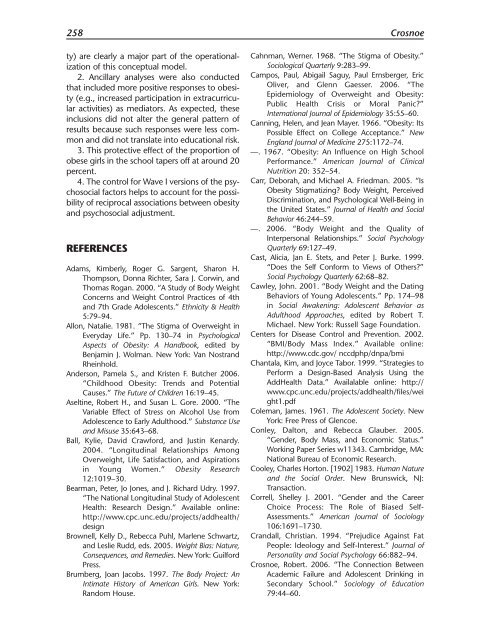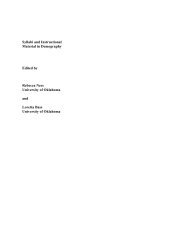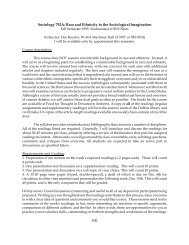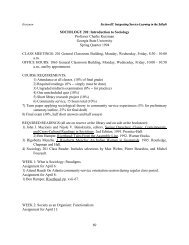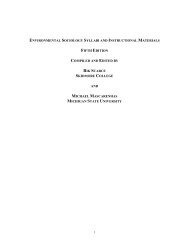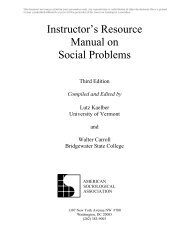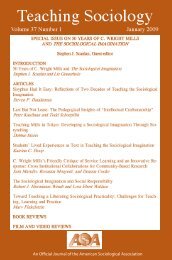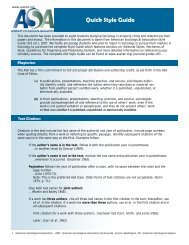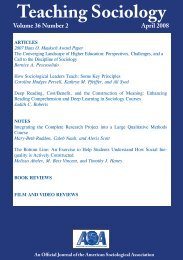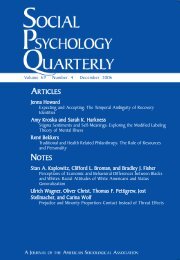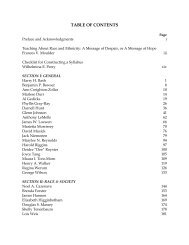SOCIOLOGY EDUCATION - American Sociological Association
SOCIOLOGY EDUCATION - American Sociological Association
SOCIOLOGY EDUCATION - American Sociological Association
You also want an ePaper? Increase the reach of your titles
YUMPU automatically turns print PDFs into web optimized ePapers that Google loves.
258 Crosnoe<br />
ty) are clearly a major part of the operationalization<br />
of this conceptual model.<br />
2. Ancillary analyses were also conducted<br />
that included more positive responses to obesity<br />
(e.g., increased participation in extracurricular<br />
activities) as mediators. As expected, these<br />
inclusions did not alter the general pattern of<br />
results because such responses were less common<br />
and did not translate into educational risk.<br />
3. This protective effect of the proportion of<br />
obese girls in the school tapers off at around 20<br />
percent.<br />
4. The control for Wave I versions of the psychosocial<br />
factors helps to account for the possibility<br />
of reciprocal associations between obesity<br />
and psychosocial adjustment.<br />
REFERENCES<br />
Adams, Kimberly, Roger G. Sargent, Sharon H.<br />
Thompson, Donna Richter, Sara J. Corwin, and<br />
Thomas Rogan. 2000. “A Study of Body Weight<br />
Concerns and Weight Control Practices of 4th<br />
and 7th Grade Adolescents.” Ethnicity & Health<br />
5:79–94.<br />
Allon, Natalie. 1981. “The Stigma of Overweight in<br />
Everyday Life.” Pp. 130–74 in Psychological<br />
Aspects of Obesity: A Handbook, edited by<br />
Benjamin J. Wolman. New York: Van Nostrand<br />
Rheinhold.<br />
Anderson, Pamela S., and Kristen F. Butcher 2006.<br />
“Childhood Obesity: Trends and Potential<br />
Causes.” The Future of Children 16:19–45.<br />
Aseltine, Robert H., and Susan L. Gore. 2000. “The<br />
Variable Effect of Stress on Alcohol Use from<br />
Adolescence to Early Adulthood.” Substance Use<br />
and Misuse 35:643–68.<br />
Ball, Kylie, David Crawford, and Justin Kenardy.<br />
2004. “Longitudinal Relationships Among<br />
Overweight, Life Satisfaction, and Aspirations<br />
in Young Women.” Obesity Research<br />
12:1019–30.<br />
Bearman, Peter, Jo Jones, and J. Richard Udry. 1997.<br />
“The National Longitudinal Study of Adolescent<br />
Health: Research Design.” Available online:<br />
http://www.cpc.unc.edu/projects/addhealth/<br />
design<br />
Brownell, Kelly D., Rebecca Puhl, Marlene Schwartz,<br />
and Leslie Rudd, eds. 2005. Weight Bias: Nature,<br />
Consequences, and Remedies. New York: Guilford<br />
Press.<br />
Brumberg, Joan Jacobs. 1997. The Body Project: An<br />
Intimate History of <strong>American</strong> Girls. New York:<br />
Random House.<br />
Cahnman, Werner. 1968. “The Stigma of Obesity.”<br />
<strong>Sociological</strong> Quarterly 9:283–99.<br />
Campos, Paul, Abigail Saguy, Paul Ernsberger, Eric<br />
Oliver, and Glenn Gaesser. 2006. “The<br />
Epidemiology of Overweight and Obesity:<br />
Public Health Crisis or Moral Panic?”<br />
International Journal of Epidemiology 35:55–60.<br />
Canning, Helen, and Jean Mayer. 1966. “Obesity: Its<br />
Possible Effect on College Acceptance.” New<br />
England Journal of Medicine 275:1172–74.<br />
—. 1967. “Obesity: An Influence on High School<br />
Performance.” <strong>American</strong> Journal of Clinical<br />
Nutrition 20: 352–54.<br />
Carr, Deborah, and Michael A. Friedman. 2005. “Is<br />
Obesity Stigmatizing? Body Weight, Perceived<br />
Discrimination, and Psychological Well-Being in<br />
the United States.” Journal of Health and Social<br />
Behavior 46:244–59.<br />
—. 2006. “Body Weight and the Quality of<br />
Interpersonal Relationships.” Social Psychology<br />
Quarterly 69:127–49.<br />
Cast, Alicia, Jan E. Stets, and Peter J. Burke. 1999.<br />
“Does the Self Conform to Views of Others?”<br />
Social Psychology Quarterly 62:68–82.<br />
Cawley, John. 2001. “Body Weight and the Dating<br />
Behaviors of Young Adolescents.” Pp. 174–98<br />
in Social Awakening: Adolescent Behavior as<br />
Adulthood Approaches, edited by Robert T.<br />
Michael. New York: Russell Sage Foundation.<br />
Centers for Disease Control and Prevention. 2002.<br />
“BMI/Body Mass Index.” Available online:<br />
http://www.cdc.gov/ nccdphp/dnpa/bmi<br />
Chantala, Kim, and Joyce Tabor. 1999. “Strategies to<br />
Perform a Design-Based Analysis Using the<br />
AddHealth Data.” Availalable online: http://<br />
www.cpc.unc.edu/projects/addhealth/files/wei<br />
ght1.pdf<br />
Coleman, James. 1961. The Adolescent Society. New<br />
York: Free Press of Glencoe.<br />
Conley, Dalton, and Rebecca Glauber. 2005.<br />
“Gender, Body Mass, and Economic Status.”<br />
Working Paper Series w11343. Cambridge, MA:<br />
National Bureau of Economic Research.<br />
Cooley, Charles Horton. [1902] 1983. Human Nature<br />
and the Social Order. New Brunswick, NJ:<br />
Transaction.<br />
Correll, Shelley J. 2001. “Gender and the Career<br />
Choice Process: The Role of Biased Self-<br />
Assessments.” <strong>American</strong> Journal of Sociology<br />
106:1691–1730.<br />
Crandall, Christian. 1994. “Prejudice Against Fat<br />
People: Ideology and Self-Interest.” Journal of<br />
Personality and Social Psychology 66:882–94.<br />
Crosnoe, Robert. 2006. “The Connection Between<br />
Academic Failure and Adolescent Drinking in<br />
Secondary School.” Sociology of Education<br />
79:44–60.


